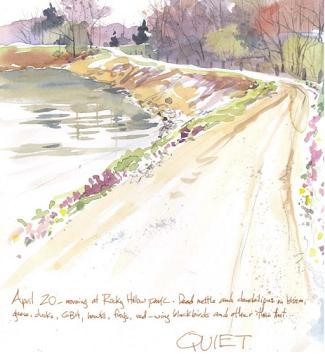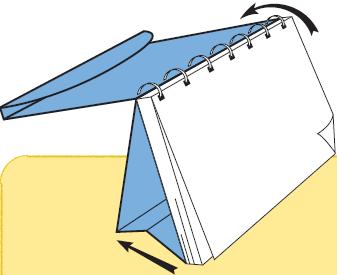
INTRODUCTION:
Watercolor Tricks & Techniques—for Today!

The original edition of this book came out more than 20 years ago, and reached a very responsive audience over a very long life. Now, with all the new tools, surfaces, materials and tricks available to the artist, it seemed time to bring it into the 21st Century and a new generation of artists. There are so many wonderful products with which to experiment, and so many new ideas! We tried to incorporate as many as possible in this book, while retaining the classics.
Watercolor is a wonderfully un-tameable medium. It’s exciting, challenging, unpredictable and fun. Oh, sometimes we may think it would be great to corral it and gentle it to our bidding, but what would be the excitement in that? Best just to jump on and ride for all you’re worth!
I admit to a fantasy on those days when I’ve been thrown by my favorite medium once too often. I imagine it would be wonderful if I could find the perfect balance between technique and vision so I could express what I see and feel, exactly the way I want to.
We all see a vision in our heads, but it seldom is just the one that evolves on paper. I sometimes play with the thought that if I could only learn enough and practice enough I’d be able to nail that vision. Every time.
But that’s not the way watercolor works; it’s alive, with a mind of its own. It can do the most exciting things, things I never dreamed of or dared hope for—these are the “happy accidents” you’ve read about. It’s also not the way human nature works, at least when it’s operating somewhere near capacity.
I may think I want control, predictability—perfection—but I don’t. Not really. I’d stagnate and become bored, and my paintings would show it. In fact, I love the dance between intent and intuition, initial vision and inspiration. I love the way a painting unfolds, suggests things to me, surprises me and invites me to try something new.
You may have fallen into a rut as we all do from time to time. Some time back, “my” brand of watercolor paper, imported from Italy, was discontinued. I was at a loss for a while, frustrated and angry. I could paint on that stuff. I knew what it would do. I knew its surface, its texture, its sizing. I knew just how much it would buckle under a wet wash. And I loved it.
But as luck would have it, I was forced to experiment, to try new things, new surfaces, new effects. I tried Japanese rice paper, rough and hot press paper. I learned my way around a variety of paper surfaces and learned just what I could expect of each. I had enlarged my repertoire. I had grown, in spite of myself, and breaking out of my comfortable rut helped my work.
Now I’ve learned to appreciate experimenting and the excitement of discovery. Sometimes it works for me, sometimes it doesn’t, but the ride itself makes me feel alive. We’ve included some of those new surfaces here, to encourage you to break out, as well. Try painting on Yupo, or Claybord, or a surface prepared with gesso—it’s fun!
How to Use This Book
The book is divided into three sections: Liquid Aids, Dry Helpers, and Indispensable Tools, with plenty of demos and inspirations salted throughout. I have explored the various techniques in a number of ways, while trying not to create hard and fast applications. Instead, I’d like this book to suggest a variety of intriguing possibilities. I wanted to avoid the tendency to see any technique in my way and my way only, so I’ve tried to keep the samples open-ended, as broad and varied as possible while still showing some of the ways I’ve chosen to use them.
Tricks vs. Techniques
Of course, tricks are no substitute for solid technique and basic skills. You’ll still need hard work and planning to produce a work of art. You’ll need to learn how to handle your medium and how to express yourself in your own unique way. It’s a natural, instinctive process, a product of the right side of your brain—your creative subconscious. It is learning how to see as well as how to paint.
It is discovering what excites you about the world you live in and learning step-by-step how, with your paints and brushes, to make that reality live for you. There’s no shortcut. Special techniques are only there to help you see and react in new ways.
One word of caution: It’s easy to get carried away with a good trick, or a whole bundle of them. Not all the tricks in your bag should (or even can) be used together at one time. And, no one trick should overpower your painting. Pick and choose carefully, with restraint. For instance, plastic wrap can be a useful tool for texturing; used with care and discernment, you’ll find it exciting and satisfying.
When a trick becomes “tricky” (facile or obvious, flashy or too universal), it detracts from your painting. Save your “ammunition” to use where it counts. Eventually, you’ll settle on a handful of tricks or special effects that fit your personality or approach. For the purposes of this book, I show several techniques that I normally don’t use. Others I save for special occasions when only the perfect trick will do.
Throughout the book, you will see my favorite tricks used more than once; others may not appear at all except in the sections where they are discussed. Although I included rough paper in the section on “Dry Helpers,” for instance, you won’t find too many examples done on this surface. It’s just not me; rough paper has a mind of its own, and so do I.
What you will see are a variety of paintings that reflect my own use of special effects. The effects you choose may be entirely different; that’s what makes watercolor the fascinating medium it is.
Have fun! Experiment, create and climb out of your rut, if you’ve fallen head first into one. And then, enjoy the challenge of incorporating new tricks and techniques into your repertoire, making them all your own.

This Book Stands on Its Own
Flatten the folded piece of cover opposite the binding to stand the book on its own. Flip the pages over to view the following page. Turn the book 180 degrees to view the book’s second half.